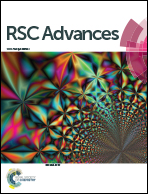Polyoxometalate (POM) grafted grooved nanofibrous membranes for improved self-decontamination†
Abstract
Combining unique fiber morphologies with self-decontamination technologies can enhance degradation of toxic compounds on fibrous substrates. Co-continuous electrospinning was used to fabricate nanofibrous cellulose acetate membranes with unique, grooved fiber morphology due to the selective dissolution of polyethylene oxide. The grooved cellulose acetate membranes were deacetylated to form grooved cellulose membranes. A self-decontaminating polyoxometalate (POM) (H5PV2Mo10O40) was synthesized and used to functionalize the grooved nanofibrous membranes as well as non-grooved nanofibrous membranes, pure cotton, 65/35 polyester/cotton fabrics and Tencel® peachskin fabric. The POM-treated substrates were exposed to methyl parathion, a simulant of the chemical warfare agent (CWA) VX, to evaluate the decontamination performance. It was found that the POM grafted, grooved nanofibrous cellulose membrane has significantly improved self-decontamination, owing to increased amount of POM grafted as a result of increased surface area. This work contributes to the use of novel fiber morphologies in breathable chemical protective apparel to achieve better CWA decontamination and comfort.


 Please wait while we load your content...
Please wait while we load your content...